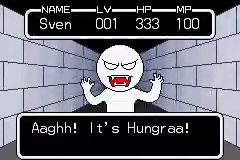This is why we can’t have nice things like dependable protection from fall damage while riding a boat in Minecraft.
Remember when US politicians argued about declaring Pi to 3?
Would have been funny seeing the world go boink in about a week.
To everyone who might not have heard about that before: It was an attempt to introduce it as a bill in Indiana:
https://en.m.wikipedia.org/w/index.php?title=Indiana_pi_bill
I prefer my pi to be in duodecimal anyway. 3.184809493B should get you to where you need to go.
Some software can be pretty resilient. I ended up watching this video here recently about running doom using different values for the constant pi that was pretty nifty.
deleted by creator
Reals are just point cores of dressed Cauchy sequences of naturals (think of it as a continually constructed set of narrowing intervals “homing in” on the real being constructed). The intervals shrink at the same rate generally.
1!=0.999 iff we can find an n, such that the intervals no longer overlap at that n. This would imply a layer of absolute infinite thinness has to exist, and so we have reached a contradiction as it would have to have a width smaller than every positive real (there is no smallest real >0).
Therefore 0.999…=1.
However, we can argue that 1 is not identity to 0.999… quite easily as they are not the same thing.
This does argue that this only works in an extensional setting (which is the norm for most mathematics).
Easiest way to prove it:
1 = 3/3 = 1/3 * 3 = 0.333… * 3 = 0.999…
Ehh, completed infinities give me wind…
Meh, close enough.
Are we still doing this 0.999… thing? Why, is it that attractive?
People generally find it odd and unintuitive that it’s possible to use decimal notation to represent 1 as .9~ and so this particular thing will never go away. When I was in HS I wowed some of my teachers by doing proofs on the subject, and every so often I see it online. This will continue to be an interesting fact for as long as decimal is used as a canonical notation.
Welp, I see. Still, this is way too much recurting of a pattern.
I wish computers could calculate infinity
0.(9)=0.(3)*3=1/3*3=1
Beautiful. Is that true or am I tricked?
The only sources I trust are the ones that come from my dreams
I can honestly say I learned something from the comment section. I was always taught the .9 repeating was not equal to 1 but separated by imaginary i … Or infinitely close to 1 without becoming 1.
Okay, but it equals one.
No, it equals 0.999…
2/9 = 0.222… 7/9 = 0.777…
0.222… + 0.777… = 0.999… 2/9 + 7/9 = 1
0.999… = 1
No, it equals 1.
Similarly, 1/3 = 0.3333…
So 3 times 1/3 = 0.9999… but also 3/3 = 1Another nice one:
Let x = 0.9999… (multiply both sides by 10)
10x = 9.99999… (substitute 0.9999… = x)
10x = 9 + x (subtract x from both sides)
9x = 9 (divide both sides by 9)
x = 1My favorite thing about this argument is that not only are you right, but you can prove it with math.
Except it doesn’t. The math is wrong. Do the exact same formula, but use .5555… instead of .9999…
Guess it turns out .5555… is also 1.
Lol you can’t do math apparently, take a logic course sometime
Let x=0.555…
10x=5.555…
10x=5+x
9x=5
x=5/9=0.555…
you can prove it with math
Not a proof, just wrong. In the “(substitute 0.9999… = x)” step, it was only done to one side, not both (the left side would’ve become 9.99999), therefore wrong.
Sure, when you start decoupling the numbers from their actual values. The only thing this proves is that the fraction-to-decimal conversion is inaccurate. Your floating points (and for that matter, our mathematical model) don’t have enough precision to appropriately model what the value of 7/9 actually is. The variation is negligible though, and that’s the core of this, is the variation off what it actually is is so small as to be insignificant and, really undefinable to us - but that doesn’t actually matter in practice, so we just ignore it or convert it. But at the end of the day 0.999… does not equal 1. A number which is not 1 is not equal to 1. That would be absurd. We’re just bad at converting fractions in our current mathematical understanding.
Edit: wow, this has proven HIGHLY unpopular, probably because it’s apparently incorrect. See below for about a dozen people educating me on math I’ve never heard of. The “intuitive” explanation on the Wikipedia page for this makes zero sense to me largely because I don’t understand how and why a repeating decimal can be considered a real number. But I’ll leave that to the math nerds and shut my mouth on the subject.
x=.9999…
10x=9.9999…
Subtract x from both sides
9x=9
x=1
There it is, folks.
Somehow I have the feeling that this is not going to convince people who think that 0.9999… /= 1, but only make them madder.
Personally I like to point to the difference, or rather non-difference, between 0.333… and ⅓, then ask them what multiplying each by 3 is.
I’d just say that not all fractions can be broken down into a proper decimal for a whole number, just like pie never actually ends. We just stop and say it’s close enough to not be important. Need to know about a circle on your whiteboard? 3.14 is accurate enough. Need the entire observable universe measured to within a single atoms worth of accuracy? It only takes 39 digits after the 3.
The problem is, that’s exactly what the … is for. It is a little weird to our heads, granted, but it does allow the conversion. 0.33 is not the same thing as 0.333… The first is close to one third. The second one is one third. It’s how we express things as a decimal that don’t cleanly map to base ten. It may look funky, but it works.
pi isn’t even a fraction. like, it’s actually an important thing that it isn’t
I was taught that if 0.9999… didn’t equal 1 there would have to be a number that exists between the two. Since there isn’t, then 0.9999…=1
Divide 1 by 3: 1÷3=0.3333…
Multiply the result by 3 reverting the operation: 0.3333… x 3 = 0.9999… or just 1
0.9999… = 1
In this context, yes, because of the cancellation on the fractions when you recover.
1/3 x 3 = 1
I would say without the context, there is an infinitesimal difference. The approximation solution above essentially ignores the problem which is more of a functional flaw in base 10 than a real number theory issue
The context doesn’t make a difference
In base 10 --> 1/3 is 0.333…
In base 12 --> 1/3 is 0.4
But they’re both the same number.
Base 10 simply is not capable of displaying it in a concise format. We could say that this is a notation issue. No notation is perfect. Base 10 has some confusing implications
They’re different numbers. Base 10 isn’t perfect and can’t do everything just right, so you end up with irrational numbers that go on forever, sometimes.
You’re just rounding up an irrational number. You have a non terminating, non repeating number, that will go on forever, because it can never actually get up to its whole value.
non repeating
it’s literally repeating
1/3 is a rational number, because it can be depicted by a ratio of two integers. You clearly don’t know what you’re talking about, you’re getting basic algebra level facts wrong. Maybe take a hint and read some real math instead of relying on your bad intuition.
1/3 is rational.
.3333… is not. You can’t treat fractions the same as our base 10 number system. They don’t all have direct conversions. Hence, why you can have a perfect fraction of a third, but not a perfect 1/3 written out in base 10.
0.333… exactly equals 1/3 in base 10. What you are saying is factually incorrect and literally nonsense. You learn this in high school level math classes. Link literally any source that supports your position.
.333… is rational.
at least we finally found your problem: you don’t know what rational and irrational mean. the clue is in the name.
TBH the name is a bit misleading. Same for “real” numbers. And oh so much more so for “normal numbers”.
not really. i get it because we use rational to mean logical, but that’s not what it means here. yeah, real and normal are stupid names but rational numbers are numbers that can be represented as a ratio of two numbers. i think it’s pretty good.
Even the hyperreal numbers *R, which include infinitesimals, define 1 == .999…
deleted by creator
I think the … here is meant to represent repeating digits.
deleted by creator
You’re being downvoted because you’re wrong.
My point was only that .9 repeating is still less than 1 in tangible measurement
If it’s less than 1, then it isn’t repeating indefinitely, which is what the ellipsis indicates.
I appreciate you taking the time, and I understand where I was wrong. Thank you
EDIT I’m going to take down my comments because it’s affecting my mental health, so for those of you that see it as deleted by creator, I made an incorrect statement, was given information on why I was wrong, and that’s about it. Please just downvote this to oblivion instead, I think I will process this being down voted better
This is the third time today I’ve seen someone admit they were wrong and thank the person that explained it to them. I know lemmy is different from reddit but holy hell that’s unheard of on the internet in general.
Keep being excellent, you and everyone else on this site.
Sort of how 0.0000001 = 0















